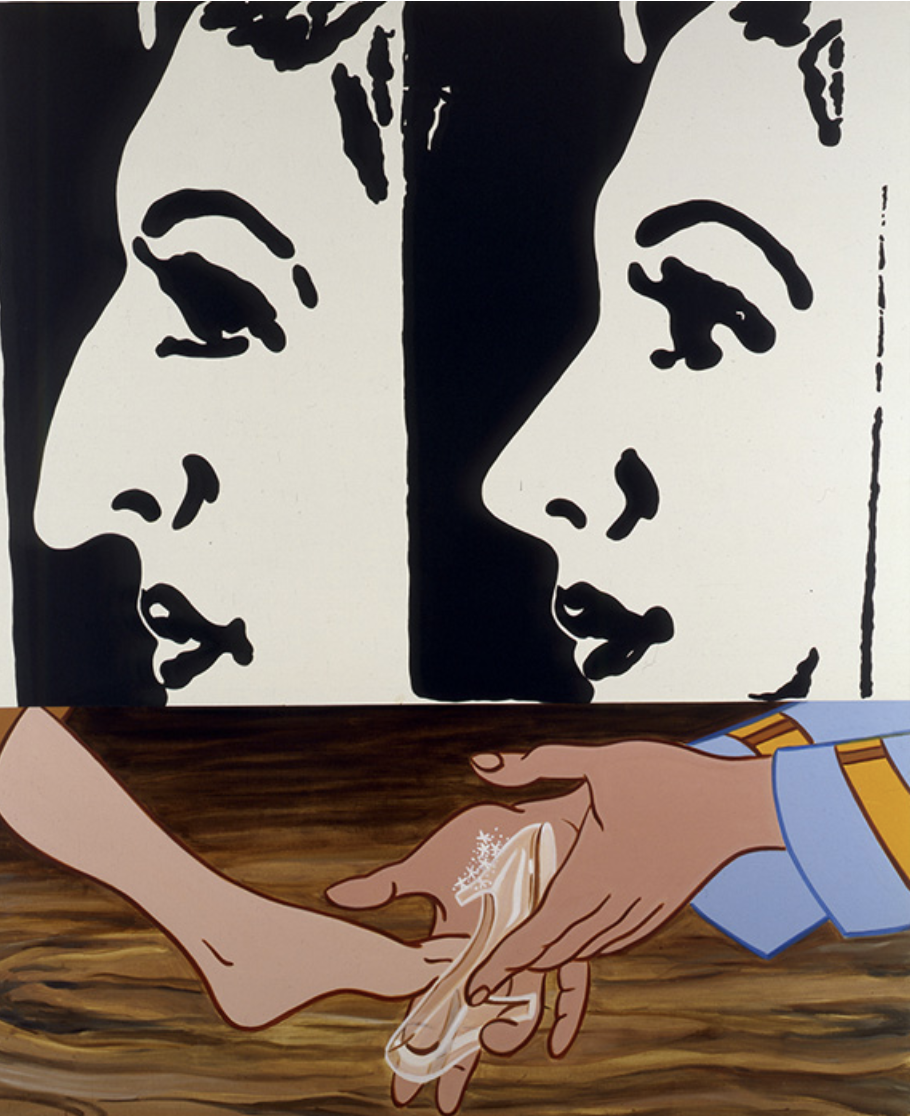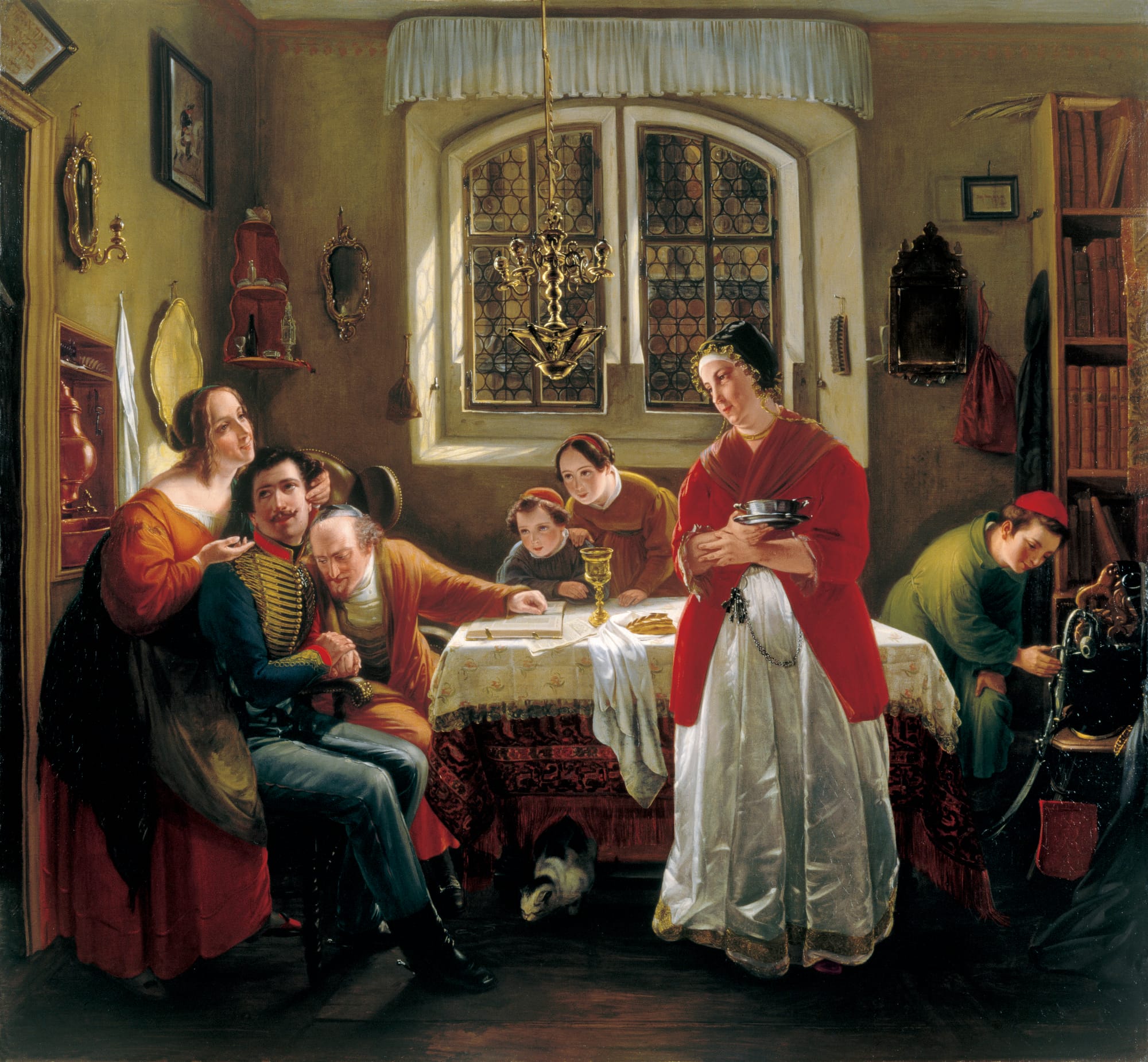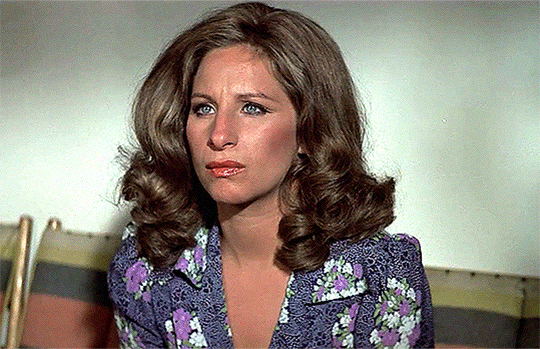Jews, Gender and Assimilation
Roots! Tropes! Tensions!

This is Life as a Sacred Text 🌱, an everybody-celebrating, justice-centered voyage into ancient stories that can illuminate our own lives. It‘s run on a nonprofit, so it’s 100% NAZI FREE. More about the project here, and to subscribe, go here:
Hi! Since I'm enjoying taking us on journeys that last more than a single missive– and since there are a few more things I'd like to do before we plunge into Deuteronomy – I want to do a lil' series on Jews and issues and around identity and assimilation that eventually lead to the US, and will eventually lead to now.
It will be a few parts. I am driving us somewhere, but I'd like to take the scenic route for a few reasons, not the least of which is that there's a lot of stuff worth noticing along the way. Learning things is good!
Today I'll talk about the Jewish move towards modernity through a gender lens.
Much of today's work draws from the historian Paula Hyman (z"l)'s masterful Gender and Assimilation in Modern Jewish History.
This will be about dominant straight cis society; there have most certainly been queer and trans people throughout history, across time and place, including across Jewish times and Jewish places– Prof. Noam Sienna's superlative A Rainbow Thread: An Anthology of Queer Jewish Texts From the First Century to 1969 certainly testifies to that. But you'll see in a sec how much I'm already trying to cram in here and how impossible it would be to get more stories or nuances into this one-post cholent. More queer Jewish history some other day.
This will also be more Ashkenazi-centric than I would like because I'm tracing the roots of US culture, which is super Ashkenormative (yes, that's a real portmanteau). Needless to say, as the events below are happening in Europe, other things are taking place in Iran, North Africa, India, China, Ethiopia, Iraq, Yemen, and in other Jewish communities around the world. [[1]] I look forward to lifting up more stories from elsewhere around global and US Jewry at other times.
But for now, let's start with the very beginnings of modernity as it came to impact the US:
If you read The Antisemitism Post (tm), you know that the Jews didn't have the best time in Medieval and Renaissance Europe, what with all the Crusades and blood libels and forced wearing of yellow IDs and prohibitions on owning land and joining guilds and the like. But!
Though things didn't magically get perfect overnight, religious tolerance was a central tenet of the 17th-18th c. Enlightenment era thinking (along with individual liberty etc). This eventually trickled down into policy, and by the very late 18th and 19th century, countries began emancipating Jews (and other marginalized groups) from discriminatory laws, and granting them equality and citizenship rights. In Germany, this process happened region by region, with the whole shebang complete in 1871.
The Haskalah (lit. "wisdom," "enlightenment")– the Jewish Enlightenment– kicked off when a young Moses Mendelssohn (1729-1786) learned Latin and got his hands on Locke's 1689 Essay Concerning Human Understanding. Eventually it became a movement that embraced modernity, supported integration in one's surrounding communities– "coming out of the ghetto"– as well as a rationalist and academic approach to text and theology and a revival of Hebrew literature– specifically, a more secular Hebrew literature. It is from this time and place that the Reform movement was born. (Judaism had been actively reconciling with science since at least the 12th c. with Maimonides, so that wasn't our issue.)
These maskilim (Haskalah-ers) existed in contrast to both the Jews who wanted to (and likely did) assimilate entirely into the surrounding culture, as well as to the more traditional rabbinic types, who wanted to preserve things as they had been. (What we think of as Ashkenazi "Orthodox" Judaism now is arguably a Judaism that has evolved, in its own way, in response to the Haskalah and the birth of the Reform movement.)

And for those who went there, the Jewish embrace of emancipation and acculturation was reflected primarily in the behavior of Jewish men.
On the other hand, due to the gender constructs of what was, frequently, the bourgeoisie setting of those who made this choice, Jewish women had fewer opportunities to interact with non-Jews in the public sphere and were, as a result, less affected by the tendency towards assimilation.
This, coupled with what Hyman called the
“prevailing bourgeois model of female domesticity…[which] called upon women to create a peaceful domestic environment… devoted to the preservation and transmission of traditional morality”
just about insured that Jewish women would become the keepers of Jewish life through Shabbat rituals, kashrut [aka kosher laws], and, especially, the Jewish education of children.
And, of course, that they would be therefore blamed for the almost inevitable assimilation of their sons.
When these women were active in the outside world, it was generally in ways that supported their roles as religious guardians– such as with charity work and the management of synagogue life. (This would translate into their being active in synagogue Sisterhoods and founding Jewish social service organizations when they arrived to the U.S.)
One wonders whether the Jewish men of this culture could have pursued assimilation as fervently as they did without the sense that a domestic "angel in the house" was anchoring them to some degree to their Jewishness, offering perhaps subconscious reassurance that, however far they went, they would never go “too far.”

Over in Eastern Europe,
the ongoing popularity of traditional Judaism and traditional Jewish learning contrasted notably with the highly secular modernity of the Russian Empire.
Jewish girls were excluded from the yeshiva system, but their families often sent them to secular public schools, so it was the girls who were most in contact with the broader culture.
And as was also the case given the Ashkenazi ideal of men engaged in full-time Torah study, this often meant that women– their wives, and sometimes daughters or sisters– were out working in the bigger world, supporting them.
This obviously helped perpetuate the model of learning as a cornerstone of Jewish male identity. But at the same time, it shaped gender norms both within the community and in contrast to the wider culture. As Talmudist Daniel Boyarin writes in the classic Unheroic Conduct: The Rise of Heterosexuality and the Invention of the Jewish Man,
While the men were sitting indoors and studying Torah, speaking only a Jewish language and withdrawn from the world, women of the same class were speaking, reading and writing the vernacular, maintaining businesses large and small, and dealing with the wide world of tax collectors and irate customers. In short, they were engaged in what must have seemed to many in the larger culture as masculine activities, [while]... the men were read as sissies....
This will have big implications once everyone gets to the US, as you'll see in a moment.
Eventually, some folks figured out what more girls getting exposed to secular education meant for the religious community, and paved the way for the establishment of some Torah learning for women and girls.
Yet for many young women exposed to the larger society, the opportunity for self-determination away from home was compelling, particularly as political movements provided another avenue for action and expression.
And this energy carried over bigtime amidst the waves of Jewish immigration to the US in the late 19th and early 20th century.
Both these young women's inclination towards activist circles and Jewish culture’s acceptance of strong, working women sowed the seeds for their involvement in secular political (particularly labor) activism in America.


Women were not only at the forefront of those movements, but, also, Jewish progressivism was in part defined by gender issues.
As Hyman notes, women were regarded
“as active subjects, rather than passive objects... [and thus] partners in negotiating the public role of Jews in American society.”
Many young women were working in factories, earning much-needed wages for their families– and, as a result, delaying marriage, and, in its stead, gaining a certain amount of autonomy and freedom over how they spent both their time and money. And they were engaging with the outside world, often becoming interested in dressing in a more "American" way (sometimes by way of the garments that they, themselves, were making by day), going to dance halls, the theater, movies, Coney Island.
These young women– known as "Ghetto Girls," [[2]] were often derided as tasteless and vulgar by wider society, and as excessively modern by their own immigrant communities.
As always! Patriarchy was gonna patriarchy.

And ultimately,
issues of assimilation in the US were no joke.
We can pretty much mark the end of Jewish (and many other communities') immigration to the US with the racist Immigration Act of 1924, which included the very racist Asian Exclusion Act. This federal law prevented immigration from Asia and set quotas on the number of immigrants from Eastern and Southern Europe in order, according to the Department of State, "to preserve the ideal of U.S. homogeneity." (It also called for creation of the U.S. Border Patrol.)
Jews (yes, even the ones from Europe with white skin) were marked as a racial and ethnic "other;" more on this, and how the assimilation to whiteness happened, coming soon.
But I'll note here: Almost 60,000 Jews from Ottoman and former Ottoman countries also got to the US before the Immigration Act– largely Ladino-speaking Sephardi Jews from the Aegean coast like Salonica and Istanbul, but also Greek-speakers from places like Corfu or Ioannina. Syrian Jews from the Aleppan (Halabi) and Damascene (Shami) communities came speaking Arabic, as well. (And, of course, Jews have come from many other points around the globe; this is hardly comprehensive.) "Western" Sephardi Jews– that is, Jews who had come more directly from Spain following the Expulsion in 1492– and Ashkenazim targeted these newcomers with racist attempts at "modernization" – that is, to acculturate them to Western ideals. And, sometimes, they simply weren't recognized as Jews at all.
But the culture clash between Jews of Western and Central European origin who were part of an earlier (mid 19th c.) immigration wave and the Yiddish-speaking greenhorns was most especially articulated by gender.
Philanthropic and programmatic assistance to the immigrants was in part an attempt to indirectly curb Eastern European Jewish women’s independence—whether in work, night school or mixed entertainment—and to behave according to middle-class American and Western European values.
To some degree, the Eastern European women did internalize these messages, taking responsibility for the transmission of crucial values to their children—sometimes with what wound up being a more secular, politically progressive Jewish identity (see: raising "red diaper babies"). Sometimes they tried to embrace both religious and modern values– but the tension between "Americanizing" and retaining Jewishness was so, so tricky. And whose job was it to hold this tension?
Women ultimately were blamed for their influence (or lack thereof) on their children.
And in the goldene medina, Jewishness could be cast off to a greater degree than ever before.
Ambivalent second-generation children created the image of the Yiddeshe Mama, whose Jewishness was both a site of fond nostalgia and the trap from which they struggled to be free, the embodiment of their failure to achieve perfect Americanization.
My Yiddishe Momme," written in 1925 by Jack Yellen and Lew Pollack-- the (sometimes suffocating) nostalgia side of the coin.
The Jewish woman was in a perfect double-bind; if she assimilated into the middle class, she was calculating and greedy, and if she didn't, she was a contemptible artifact of a bygone era.
As journalist Jamie Lauren Keiles put it,
The Jewish novelists of the midcentury — men like Philip Roth, Saul Bellow, and J.D. Salinger — were stewards of a new Jewish American literary canon, replete with its own set of archetypes and tropes. The first was the Jewish mother figure. Consumed by her nagging, overbearing affectations, the Jewish mother was to blame for the persistent woes of the Jewish American male — his anxiety, his neuroticism, his own assimilation failures. Her image was designed to absorb the stigmas of the old world.
Her inverse, the JAP [the Jewish American Princess, natch] was entitled and withholding, designed to take blame for the stigmas of the new. If the WASP still saw the Jewish man as nouveau riche — even after so much Americanization — then surely there must have been a third party to blame. The JAP was a woman who had overshot the mark, piling on the trappings of the stable middle class like so many diamond tennis bracelets.
Portnoy’s Complaint, by Philip Roth, was instrumental in this trope-shaping, with passages about women with adorable phrases like,
“It isn’t their fault they were given a gift like speech — look, if cows could talk, they would say things just as idiotic. Yes, yes, maybe that’s the solution then: think of them as cows, who have been given the twin miracles of speech and mah-jongg.”

"Roth, who achieved true greatness in depicting people like himself, never had the imagination to give these women souls."

Remember Boyarin, above, describing the archetype of Jewish men sitting inside studying Torah, and how it (implicitly) contrasted to the dominant muscular gentile masculine ideal? As he wrote elsewhere in the same book:
"I start with the widespread sensibility that being Jewish in our culture renders a boy effeminate,"
Those traditional tropes of "sissy" masculinity became particularly challenging during those Postwar American Assimilation Years. Especially when coupled with our tradition of empowered women.
In 1976, journalist Bob Lamm articulated this– and its impacts– for Lilith Magazine, writing,
Jewish men ...try desperately to prove to Christian men that we can keep women in line just as casually and gracefully as the Redfords and the Kennedys. For only then will Christian men respect us; only then will they consider us for equal membership in a patriarchal society.
Thus, the strength, courage, and independence of Jewish women become a particular threat to Jewish men...If Jewish women appear “uppity” in the eyes of Christian men, then Jewish men will be viewed as weak and unable to rule our own culture.
And for a long time, this tension around assimilation’s gendered identity endured.
One need only glance at portrayals of Jews in pop culture over the years, for example. For decades it was usually regarded as fine, even appealing to retain popular Jewish men’s Jewishness, fictional or real–trace this starting wherever you want, pick it up: Milton Berle, Lenny Bruce, Friends’ Ross Gellar, Larry David, Jerry Seinfeld, Ben Stiller, Adam Sandler, and so on and so forth. These dudes could cash in on their identity.
Popular female characters/celebs, on the other hand, for decades had to mitigate their Jewishness almost entirely in order to be well-received. The ingénue had to acculturate to the point of erasure: nebbishy Ross’ sister Monica was a picture of WASPish punctiliousness, Mean Girls' Gretchen Weiner's background was only observable with a comment about Hanukah. These women were allowed, at most, a soft, lovable JAPpishness, Friends' Rachel Green or Grace of Will and Grace could love shoes and still be pretty, sure —but there was an invisible line. Cross it, and the Jewish woman became shrill, cartoonish: The Nanny’s Fran Dresher or Girls’ Shoshanna, Clueless' Cher Horowitz: too overt, gaudy and embarrassing. "Ghetto Girls" 2.0. And the Jewish mother, of course, has her own iconic trope, whether The Goldberg's Molly Goldberg, Kyle's mom on South Park or whatever in-between or beyond. [[3]]
It's only in recent years– an extra generation removed from Portnoy and Marjorie Morningstar–that things have begun to get better in broader* ways.
*(pun(s) intended)
Samantha Pickette, a Jewish Studies professor and author of a book on the topic noted that the last decade-ish of rep– including but not limited to Abby & Ilana from Broad City, Cynthia Tova (“Black Cindy”) Hayes from Orange Is The New Black, Rebecca from Crazy Ex-Girlfriend, Nadia of Russian Doll, Tiffany Haddish in Black Mitzvah and other shows and movies finally
undermine historical representations of Jewish femininity, complicating and, in many cases, bypassing altogether the Jewish Mother/JAP cul-de-sac of Jewish female representation in order to establish new tropes. Secondly, and perhaps more importantly, they humanize the Jewish woman by individualizing her.
Finally, finally, she gets to be herself, in all the ways that she can exist, on her own terms.
She can be both fully Jewish– in the exquisite range of manifestations and possibilities for what that might mean– and fully realized, fully human.
Laura Elkeslassy's Ya Ghorbati is a musical project about Arab-Jewish identity, her family's exile from Morocco, and reviving great Maghrebi artists and art. Elkeslassy writes that, together with a collaborator, found "a broad swath of music composed and performed by Jews in North Africa... We wove together liturgical material with folk music and cabaret, wedding songs traditionally sung only by women with holy songs traditionally sung only by men. We were particularly attracted to the voices and stories of women and queer folks of the time. " More here.
Directed by Olivia Peace and written by Jess Zeidman, Tahara follows Carrie (Madeline Grey DeFreece) as she processes the death of a classmate with other members of her Hebrew School, as well as her longtime (and toxic) relationship with Hannah (Shiva Baby's Rachel Sennott).
Danielle Dardashti & Galeet Dardashti created a podcast tracing their family immigration story, full of mysteries and big questions:
🌱🌱🌱🌱🌱🌱🌱🌱🌱🌱🌱🌱🌱🌱🌱🌱🌱🌱🌱🌱🌱🌱🌱🌱🌱
Like this? Get more of it in your inbox every week. 🌱
For free every Monday—sign up at the ‘Subscribe now’ button just below.
And if you become a paid subscriber, that's how you can get tools for deeper transformation, a community for doing the work, and support the labor that makes these Monday essays happen.
A note on the subscription model:
I want my work to be as accessible to as many people as possible, in as many ways as possible. That's why the Monday essays are free, and why we donate subscriptions to anyone for whom paying is a barrier to the House of Study posts.
I also believe people should be paid fairly for their work. Needless to say, these two values sometimes seem to be in conflict, but I do what I can to find a fair balance. I offer many resources for free, and charge for others. When you donate generously or pay at the top of our scale, that helps support the work I do, provides access for those who have fewer resources, pays for the infrastructure and the technical and practical support that it takes to do this, and helps us keep the work sustainable.
And as always, if you want in to the Thursday space but paying isn't for you now, just email support@lifeisasacredtext.com and we'll hook you up.
And if you’d like to underwrite one of these donated subscriptions, you can do so by signing up at one of the higher subscription points.
And if it resonated with you, please share this post.
Sending a big pile of blessings and goodness your way. 💕
[[1]]: According to Pew's 2020 data, 2/3 of US Jews identify as Ashkenazi, 3% identify as Sephardi, 1% as Mizrahi and 6% more say that they are some combination of these or other categories. (And then 17% said "Just Jewish" and 8% answered "none/ not sure /refused.") Again, being a minority population doesn't justify Sephardi / Mizrahi erasure, but it explains why, when we're tracing the roots of certain dominant tropes, we're looking to their origins.
[[2]]: As in: the ghettos in which the Jews were forced to live in Europe, except now the ghetto was the Lower East Side. The vitriol directed here smells like the same classist misogyny we've seen play out in many other times and places, aimed at many other cultures and communities. E.G. in 1918, Marion Golde wrote an article in the American Jewish News titled, “The Modern Ghetto Girl: Does She Lack Refinement?,” in which she stated that "The fashionable dress of the East-side girl shrieks its cheapness and mimicry of the real thing… Her exaggerated coiffure, with its imitation curls and soaped curves that stick out at the side of the head like fantastic gargoyles, is offensive to the eye. Her plated gold jewelry with paste stones, bought from the Grand Street peddlers on pay-day reveles its cheapness by its very extravagance."
[[3]]: Yes, there were the occasional exceptions to this pop culture triad of a) castrating mother b) overbearing gaudy princess c) appropriately "pretty," toned down assimilated woman (see also: rhinoplasty, hair straightening, other attempts to lessen ethnicity of appearance). (Also note that "shiksa goddess" is so ubiquitous as to get its own TV Tropes.com entry.) But the reason that, say, the Barbara Streisands and Dirty Dancings were celebrated so wildly was precisely because they were the exceptions– because, what, a Jewish girl with a nose like that could be the love interest??? Representation matters, always has.
But wait! there's more....!! ✨
A great piece on Jewish gender stereotypes in the US from anthropologist Riv-Ellen Prell here, and a meaty, long piece on assimilation in the US by historian Deborah Dash Moore is here.
Sarah Aroeste's Sephardic roots are from N. Macedonia and Greece. She sings in Ladino, the Judeo-Spanish dialect which, after the Spanish Jews' expulsion from Spain in 1492, absorbed bits of Greek, Turkish, Portuguese, French, Italian, Hebrew, and more:
Rabbi Deborah Sacks Mintz' latest album is a collection of new melodies paired with texts from many corners of the Jewish liturgical tradition. A niggun is a traditional wordless melody, and "Yetzira" is one kind of creation:
Since it's almost that season again (can you believe it?), here's Anat Halevy Hochberg's contribution to the Elul Music Project (Elul is the month just before the High Holy Days, Tishrei is the month that begins with Rosh Hashana):
And to close us out and take us (thematically) back around again, here's a lovely version of a Yiddish song about longing for the old days by Tatiana Wechsler:




